Background
Achmea is a well known insurance company in the Netherlands. They created a corporate video in which five different protagonists are followed as something is going to happen to them (both positive and negative events). Due to its storytelling angle, the video really stands out and Achmea wanted to know how effective the video is. Check the video here below:
How we studied the video
We split the video into 5 shorter clips (around 40/50 seconds each) to better grasp the emotions activated throughout. The video was divided based on the progression of the storyline. There was an impressive build-up of emotions. Parts 1-3 showed a good balance between positive and negative emotions whereas parts 4-5 activated more positive emotions. You can see this in the diagram below.
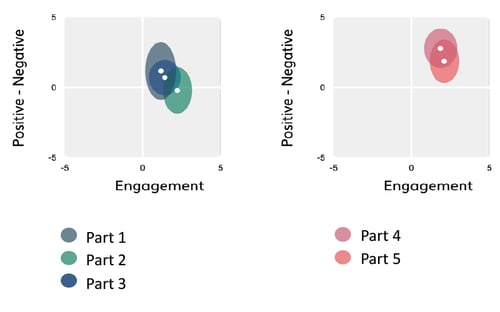
Each section was viewed in an MRI scanner, allowing us to see the emotions activated in the brain. Once we had the results from the fMRI study, we asked a group of participants to explain why they believed certain emotions were activated in others.
We also looked at the timeline of emotions from the MRI scanner. This permitted us to see the fluctuations of positive and negative emotions throughout the advertisement.
Eye tracking technology was used to visualise which parts of the video attracted the viewers’ attention. Together, these techniques provided a complete overview of which emotions were activated whilst watching the commercial and why they were activated.
Parts 1 and 2 – Effectively showing negative visuals without activating negative feelings
In the first part (0-0:39) the story builds up. The viewer sees the countdowns to the events in the protagonists’ lives, activating a high feeling of novelty. This opening to the story made the beginning impactful, the viewer is intrigued as to what will happen and wants to continue watching. Trust levels were low because the viewer was unsure about whether the endings would be pleasant. The mood of the video, combined with the countdowns, indicated that something negative was likely to happen.
Interestingly, despite the announcement of negative events in the first part, negative emotions weren’t strongly activated. Respondents indicated that this could be because although the viewer read about the negative events on-screen, they hadn’t seen them yet. The warning of the negative events to come didn’t activate negative emotions. Moreover, the behaviour of the people in the scene was positive.
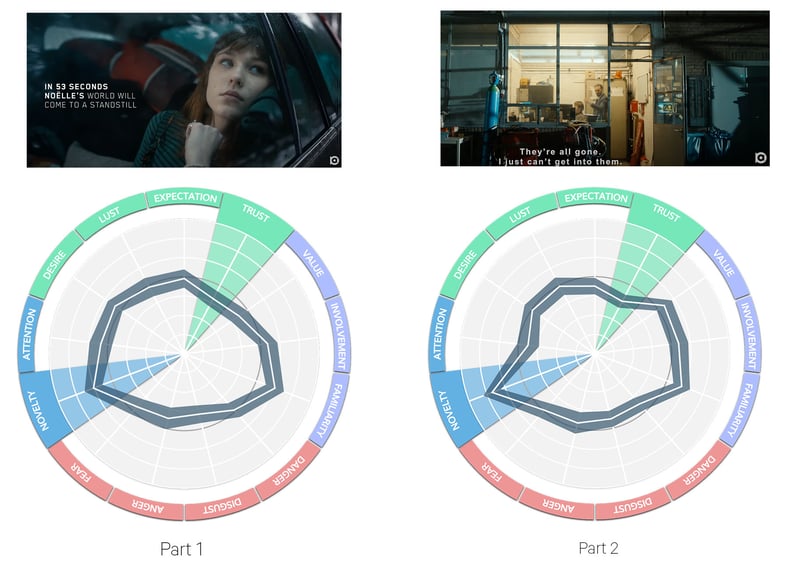
In the second part (0:40-1:33), even though the viewer sees the disasters unfold, there weren’t strong negative emotions activated either. The participants explained that this was because the viewer was already prepared for the negative events to occur because of the text in part 1. The text and disaster scenes ensured enough impact (novelty) without activating too many negative emotions. Additionally, the music activated novelty: what is going to happen? Is a solution coming?
Overall, in these first two parts, there is a balance of positive and negative emotions. We see that negative scenes don’t always equate to negative emotions. This is due to the storytelling nature of the video as the viewer knows that there is more to come.
Deel 3 - Gevoelens van zekerheid ondanks negatieve gebeurtenissen
In the third part (1:34-2:19), the story progresses as the protagonists receive help. Certainty and clarity were activated when it became clear how the negative event would be resolved, and help was offered by others. For example, when the passer-by runs to the scene of the crash and calls an ambulance. See the timeline below.
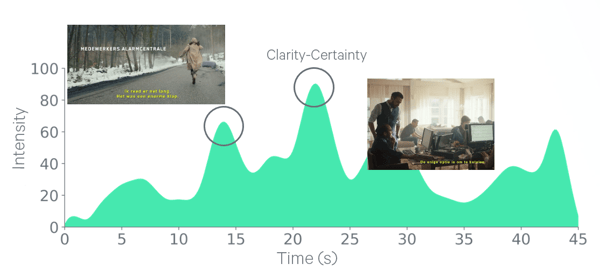
Desire also increased as the viewer saw the protagonists being helped, which provided hope for a positive future and sympathy for the unfortunate events. These scenes activated positive emotions and were valued by the viewers. The hint of possible happy endings for the protagonists ensured that positive emotions were activated.
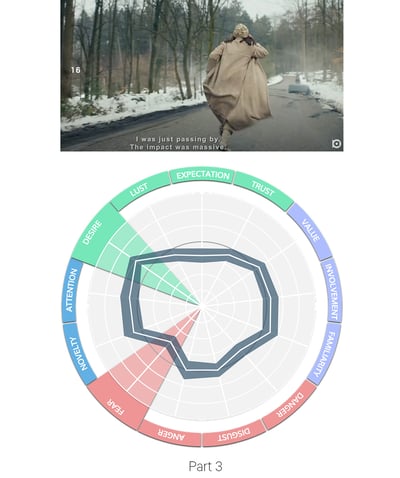
The positive and negative emotions fluctuated rapidly as scenes of the disasters were shown in quick succession with the scenes of the victims being helped. This caused a neutral balance of emotions overall, see the timeline below (when the line is above 0, this indicates positive emotion; below 0 indicates negative emotion; around 0 indicates neutral emotion).
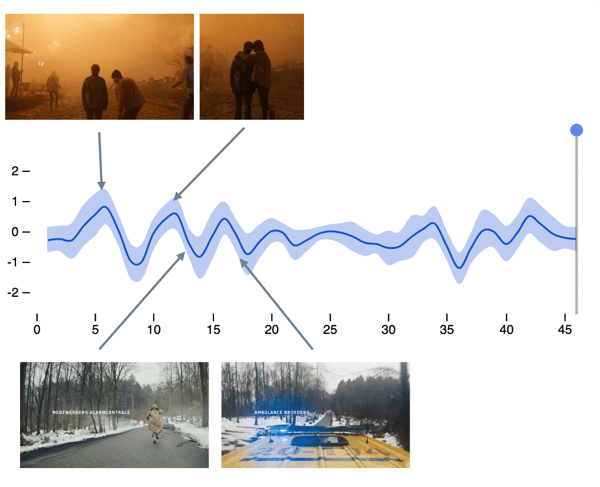
Part 4 – The beginning of strongly activated positive emotions
Starting from the fourth part (2:20-3:10), positive emotions were very strongly activated. For the first time, the positive emotions outweighed the negative ones. There were high scores in Desire, Involvement and Expectation. This part of the story sees the protagonists coping shortly after the big events in their lives.
Involvement increased when the protagonists were given help. The transition in the storyline from problem to solution led to strong feelings of involvement. This change to a hopeful future also activated a feeling of Desire. Desire was further activated by the scenes where the viewer saw the victim appreciating the help given.
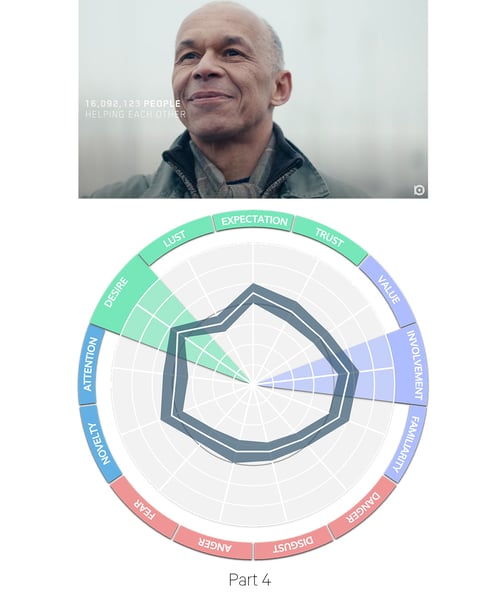
The build-up of music and the smiling faces added to the activation of positive emotions (see timeline below). The viewer highly values the happy ending, which is reflected in the overall positive emotion score.
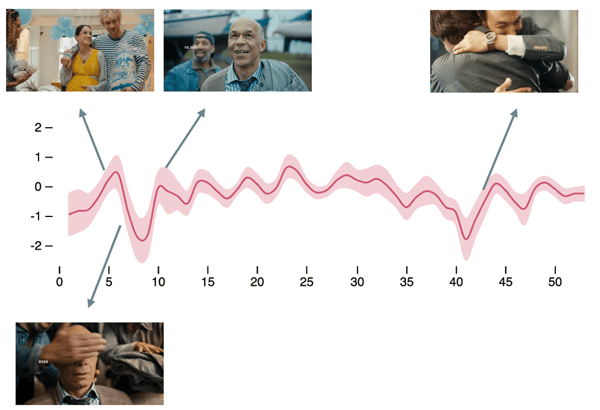
Part 5 – A happy ending
The final part acts as an epilogue to the story as you see how things are going after the events. The happy endings of part 4 activated positive emotions and maintained the feeling of Involvement. The build-up of the music in part 5 activated strong expectation feelings. This led to even stronger feelings of Involvement when seeing the next heart-warming scene: the mother and daughter at graduation.
The viewers also mirrored the rewarding feelings that the protagonists felt after all their hard work. For instance, when the girl received the applause at her graduation.
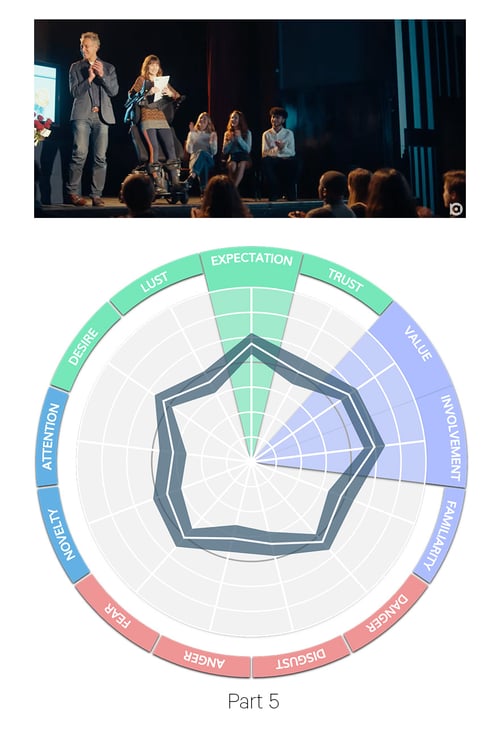
As the video ended with positive emotions, these emotions will remain in the viewer after watching it and will be what they remember. Therefore, it’s unsurprising that the results of the last two parts of the commercial fall in our top 15% of the most effective ads.
Brand association
We also measured if the respondents were able to identify which company had produced the video. It turned out that the brand Achmea was strongly associated. Furthermore, the key message of the video was to help each other when things go wrong, and this message was well-understood by 70-80% of the viewers. They told us they believed the message was: “we are stronger together” and “Achmea is ready to help you”.
Conclusions
Overall, the emotional reaction to this video was very good. There was an impactful beginning with a happy and rewarding ending that was valued by the viewers. Not many negative emotions were activated throughout the video. The novelty of the video led the viewer to keep watching as they wanted to know the ending.
The positive feelings came from the scenes in which the negative events were resolved. The smiling faces of the people in the video ensured that there could be a balance between positive and negative emotions, which is crucial for an effective advertisement .
These results show that the story-telling angle of this ad proved to be a successful and effective approach. Scenes depicting negative events don’t necessarily result in negative emotions being activated. It all depends on the build-up of the story.
How can this help you?
- Do you wish to know whether your corporate video is effective?
- Do you wonder which emotions are most strongly activated in your corporate video?
- Do you want to make sure your storytelling angle is activating the right balance of emotions?
Neem contact op
Andries van der Leij
Head of Research & Development
Meer weten over onze onderzoekstechnieken?

Start een project
Heb je vragen over wat Neurensics voor jou kan betekenen? Neem dan snel contact op met Walter.

Walter Limpens
Heb je vragen over de onderzoekstechnieken die Neurensics gebruikt? Neem dan snel contact op met Andries.








